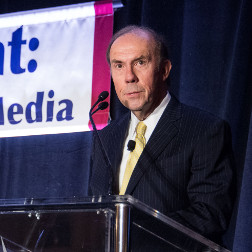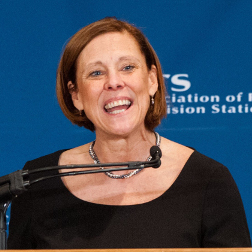APTS Members Pledge to Support FirstNet
WASHINGTON—Last month, at its annual Public Media Summit, America’s Public Television Stations (APTS), formerly the Association of Public Television Stations, announced efforts to create a national hub and committed to set aside spectrum for an upcoming first-responders network. APTS will run the Public Media Public Safety Coordination, which will also coordinate work of PBS Warn, the redundant path for FEMA wireless emergency alerts, as well as NPR, which will incorporate radio into the initiative.

In a unanimous vote the stations committed—at least in principle—to each allocating 1megabit per second of spectrum for the First Responder Network Authority (FirstNet), nationwide public safety network.
“This is the early days of FirstNet as far as that is concerned,” said Patrick Butler, APTS president and CEO. “This fills the void in ensuring that first responders receive the information they need in a time of crisis.”

Patrick Butler
The creation of FirstNet was signed into law on Feb. 22, 2012 as part of the Middle Class Tax Relief and Job Creation Act, and the law gives FirstNet the mission to build, operate and maintain the nation’s first high-speed, nationwide broadband network that is dedicated to public safety. It came about after Congress allocated spectrum along with up to $7 billion in funding for the construction of the network, while FirstNet is further leveraging existing telecommunications infrastructure and assets that include exploring public and private partnerships to help support and accelerate the creation of this wireless network.
“The money set aside by Congress may not be enough to sustain it,” added Butler. “Public TV is proud to play a role to help support it.”
IMPORTANCE OF BROADCASTERS IN AN EMERGENCY
Get the TV Tech Newsletter
The professional video industry's #1 source for news, trends and product and tech information. Sign up below.
Today with Americans ever more connected via mobile apps, broadband computers and satellite radio, the question becomes how important broadcasters—in particular public broadcasters—still are in regards to EAS.
“Broadcasters are still relevant to emergency alert networks, although not as relevant as they would have you believe,” said Steve Blum, founder and principal analyst at Tellus Venture Associates. “The public is increasingly unlikely to be watching an over-the-air broadcast directly.”
Other means, such as mobile network messaging and integration into cable and DBS systems, are more efficient at reaching individuals, Blum feels.
“But unlikely doesn’t mean never, and emergency communication is about ubiquity, not efficiency,” he said. “In an emergency, it’s about pushing information out via all possible means. At any given moment a significant number of people are engaged with any form of media you can name, so you have to use all forms of media if you want to reach the greatest number of people in the shortest amount of time.”
There are also the issues of how the messages are sent in a crisis and the scale of an emergency.
“Even for people who rely on a smartphone for their information there is a limit when the messaging that is available has a 90 character limit,” said William T. Hayes, director of engineering and technology for Iowa Public Television. “With TV there is the ability to not only put up the textual warning for a tornado but a graphical map that shows where it is. The other thing is that where broadcast tends to shine is when you look at a large scale emergency. In disasters such as large scale flooding the cellular infrastructure can fail.”
Then there is the case of the audience as well.
“There are still plenty of Americans who still do things the old fashioned way,” said Jeff Kagan, telecom analyst and industry consultant. “So we need to make sure we can reach everyone with EAS.”
This may include the elderly, lower income and rural families that may not have access to broadband, and who may not be adopters of the latest smartphones. Public TV however certainly has a reach with those audiences.

Lonna Thompson
“This goes back to the universal service mandate that created this entity and oversees public TV,” said Lonna Thompson, APTS executive vice president, chief operating officer and general counsel. “We reach about 99 percent of the country, including those rural areas where it isn’t profitable for others to go, and where it is expensive to build broadband.”
GETTING TO FIRST RESPONDERS
The other important part of FirstNet—as noted by its full name—is that it is a system that will ensure first responders can get the information that they require in a time of emergency as well.
While it will use the same spectrum FirstNet can be data embedded so that information sent to first responders won’t appear on regular TVs.
“That same data casting can be used to feed any receivers including those in police cars, in fire trucks and other emergency vehicles or even in schools,” said Thompson. “Our PBS stations are doing this and it is important for the first responders. This network is designed not to overload, and we can send tons of video without overloading the networks to first responders.”
One example that Thompson highlighted was how helicopters could send out footage from the air to any first responder receivers on the ground. Public TV plays an important role in this for a number of reasons.
“Most stations own their own towers, so our part of this could be accomplished very quickly,” she added.
The efforts to reach first responders won’t be limited to public TV, as radio will also play a crucial role. NPR has announced efforts that it will ensure that crucial information can also be relayed to first responders in a time of emergencies via a private two-way broadband network. This network is part of the upcoming upgrade to the Public Radio Satellite System (PRSS) that will provide improved bandwidth efficiencies.

Michael Beach
“During a crisis, efficient communications can make a difference in responding to need,” said Michael Beach, vice president for NPR Distribution, which manages PRSS.
“Local radio broadcasters fill a vital role in sharing emergency information with the public in a clear way that is not dependent on the Internet or the electrical power grid,” Beach said. “NPR Distribution provides an important service by sharing national level emergency information with local public radio stations.”
At present the PRSS staff is working with the Corporation for Public Broadcasting (CPB) staff to finalize the proposal. To date, consultants from Cognizant Technology Solutions, which has advised CPB on interconnection upgrades for both public TV and radio, have been reviewing PRSS. The consultants have called upon PBS and NPR to seek ways to consolidate network operations.
While costs of this network are an issue, for cash-strapped public TV it could be a revenue stream as well, as first responders will pay for the systems, which APTS estimated could be in the tens of millions of dollars every year, so the stations could be doing well by doing good.
“We believe that public broadcasting is public service, and we are committed to delivering this service,” added Iowa Public TV’s Hayes. “We hope it never needs to be used, but we are willing to commit to it so it is there if needed."
